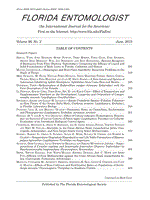Since the chilli thrips, Scirtothrips dorsalis Hood (Thysanoptera: Thripidae) poses a considerable threat to production of peppers in the Western Hemisphere, it is important to determine the relative vulnerability of different cultivars of Capsicum annuum L. and C. chinense Jacquin. In addition it is important to determine the relative benefits to the productivity of these cultivars of controlling the chilli thrips with insecticides. Therefore the effects of the chilli thrips on 11 pepper cultivars (Capsicum spp.; Solanales: Solanaceae) were tested in greenhouse and laboratory environments. When data for spinetoram-treated and untreated plants of each cultivar were pooled, the number of pedicels, number of flowers, and total (pedicels flowers fruit) differed between cultivars, and ‘Astry’ and ‘Cheyenne’ had the highest counts of these organs, while ‘Hot Habanero Orange’ and ‘Hot Fatalli’ had the least. When cultivars were pooled for spinetoram-treated separately from untreated plants, spinetoram was found to have increased the numbers of pedicels and total counted plant organs. For spinetoram-treated plants, ‘Hot San Ardo’ had the greatest canopy volume and ‘Hot Fatalli’ the smallest, whereas ‘Fresno 6022’ had the most fruits and ‘Hot Fatalli’ had the least. Based on comparing canopy volume and number of fruits of spinetoram-treated and untreated plants, ‘Numex Big Jim’ was found to have been benefitted the least by spinetoram application, whereas ‘Fresno 6022’, ‘Hot Tormenta’, ‘Cheyenne’, ‘Astry’, and ‘Jamaican Yellow’ were benefitted the most. A greenhouse choice test indicated ‘Fresno 6022’, ‘Hot Tormenta’, ‘Hot Fatalli’, ‘Hot San Ardo’, ‘Hot Habanero Orange’, ‘Numex Big Jim’, and ‘Jamaican Yellow’ each had fewer larvae per plant than ‘Astry’. In a choice of cultivars in laboratory Petri dishes, larvae per leaf disk were most abundant on ‘Agriset 4108’, ‘Red Devil Cayenne’, ‘Numex Big Jim’, ‘Astry’, and ‘Jamaican Yellow’ and least abundant on ‘Hot Fatalli’. ‘Hot Fatalli’ attracted the fewest thrips and seemed to be the least susceptible cultivar in the 3 experiments, though it had the smallest plant size and lowest yields. Spinetoram improved yields of productive cultivars like ‘Fresno 6022’, which may be more feasible to grow than ‘Hot Fatalli’.
How to translate text using browser tools
1 June 2013
Responses of Chilli Thrips (Thysanoptera: Thripidae) to Capsicum Cultivars in Choice Tests in the Greenhouse and Laboratory and Relative Benefits of Protecting these Cultivars with Spinetoram
Cliff G. Martin,
Dakshina R. Seal

Florida Entomologist
Vol. 96 • No. 2
June 2013
Vol. 96 • No. 2
June 2013
Capsicum annuum
Capsicum chinense
Scirtothrips dorsalis
spinetoram




